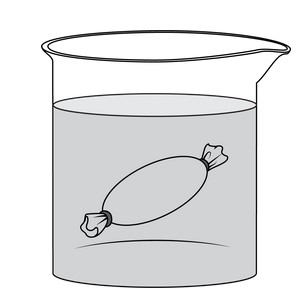Question

Figure 1
A student is using dialysis bags to model the effects of changing solute concentrations on cells. The student places one dialysis bag that contains 25 mL
of distilled water into each of two beakers that are filled with 200 mL of distilled water. (Figure 1). The membrane of each dialysis bag membrane contains pores that allow small solutes such as monoatomic ions to pass through but are too small for anything larger to pass. After 30 minutes, 5 mL
of a concentrated solution of albumin (a medium-sized, water-soluble protein) is added to one of the two beakers. Nothing is added to the other beaker. After two more hours at room temperature, the mass of each bag is determined. There is no change in the mass of the dialysis bag in the beaker to which no albumin was added.
Which of the graphs below best represents the predicted change in mass over time of the dialysis bag in the beaker to which albumin was added?
A.

B.

C.

D.

▶️Answer/Explanation
Ans: B
The graph indicates no change in the mass of the dialysis bag for the first 30 minutes in an isotonic environment and then shows a decrease in mass when the environment became hypertonic with the addition of albumin.
Question
Some viral infections can lead to the rupture of the lysosome membrane. Which prediction of the effect of this disruption of cellular compartmentalization is most likely correct?
A. Enzymes will be released that will specifically target the virus.
B. Cellular osmotic concentrations will change, preventing viral entry into the cell.
C. Hydrolytic enzymes will be released, which will cause cell death.
D. Intracellular digestion of organic materials will increase, which will increase the energy available to the cell for fighting the virus.
▶️Answer/Explanation
Ans: C
Hydrolytic enzymes will be released, resulting in cell death and preventing further viral reproduction.
Question
Gaucher disease is an inherited disorder in which cells of the body are unable to break down a particular type of lipid, resulting in a buildup of the lipid in some tissues and organs.
Based on the information provided, Gaucher disease results most directly from a defect in the function of which of the following organelles?
A. The smooth endoplasmic reticulum
B. The nucleus
C. The lysosome
D. The mitochondrion
▶️Answer/Explanation
Ans: C
The lysosome contains specific enzymes used to break down a variety of molecules and cellular waste products. A defect in the function of the lysosomal enzymes that are needed to break down lipids is the most direct cause of Gaucher disease.
Question
Membrane-bound organelles are present in practically all eukaryotic cells. Which of the following statements most accurately summarizes
the advantage of internal membranes in eukaryotic cells?
(A) Membrane-bound organelles like the mitochondria and
chloroplast are capable of semiautonomous replication.
(B) Internal membranes form partitions that can isolate specific
reactions, increasing metabolic efficiency and the range of
metabolic activities the cell can perform.
(C) Internal membranes allow prokaryotic cells to reside within
eukaryotic cells to form cooperative cells.
(D) Compartmentalization allows cells to reproduce faster and with
greater efficiency.
▶️Answer/Explanation
Ans: B
Internal compartmentalization allows the cell to perform many
different processes concurrently yet separately. Each compartment can
have its own environment. For example, the low pH lysosome performs
digestion, while the smooth endoplasmic reticulum is synthesizes lipids and
transcription is occurs in the nucleus.
Choice A is incorrect because most organelles are NOT capable of semi-
autonomous replication. The mitochondria and chloroplasts are exceptions
(see answer 28 for an explanation of the endosymbiotic hypothesis).
Choice C misstates the endosymbiotic hypothesis. Although the
mitochondria and chloroplast can be thought of as prokaryotes living in
cooperation with the eukaryotic cell, all the other membrane-bound
compartments of the cell are not prokaryotes.
Although compartmentalization confers many advantages to cells, it
does not allow them to reproduce faster. Prokaryotic cells reproduce many
times faster than eukaryotes (some species can divide every 20 minutes
under ideal conditions)! Of course, there are many factors that contribute to
their shorter reproduction time. A significant factor is their DNA replication
rate. Prokaryotic DNA polymerase works about 10 times faster than the
eukaryotic DNA polymerase AND bacteria have about 1/1,000th the amount of DNA.
Question
If the ER (endoplasmic reticulum) is completely removed from a cell, the cell can function normally for a short time but is unable to
synthesize new ER during this time. Which of the following is the most likely explanation for this phenomenon?
(A) The genes for ER synthesis are present in the ER.
(B) The ER is not an obligatory organelle in most cells.
(C) The genes for ER synthesis are irreversibly turned off once cell
development is complete.
(D) The information required to construct the ER does not reside
exclusively in the DNA.
▶️Answer/Explanation
Ans: D
Most membrane-bound organelles can only be synthesized from
“pieces” of membrane-bound organelle. During cytokinesis, the
endomembrane system (including the golgi and ER) is divided up into
daughter cells. These fragments of membrane are used to construct new
membrane. The mitochondria and chloroplast are important exceptions.
These organelles are capable of semi-autonomous replication within cells (they used to be free-living prokaryotes). Still, organelles come from pre-existing organelles in some form.
